Outdoor gas boilers: standards and requirements for the placement of outdoor equipment
One of the ways to set up heating in residential or non-residential premises is to install the equipment not in the boiler room or inside the building, but on the street. Outdoor gas boilers can be responsible for heating the house. These are standard units in an insulated casing with a chimney and a pipeline connecting them to heated rooms.
The complexity of installing the PRC lies in the requirements imposed by the supervisory authorities, as well as in the conditions of their placement. Let's consider the design and installation features of outdoor equipment, despite the fact that there is no separate legislative framework for this type of heating equipment.
The content of the article:
Outdoor gas boilers
Many Russian and foreign enterprises are engaged in the production of outdoor installations. The main advantage is that powerful units do not require the construction of a separate boiler room, but are fully protected from mechanical damage, cold and rain.
Various models of outdoor gas boilers are designed to operate on natural, liquefied gas and biogas and have an efficiency of 85-95%. The pressure in the system and the outlet water temperature vary, but in some units they are regulated automatically.
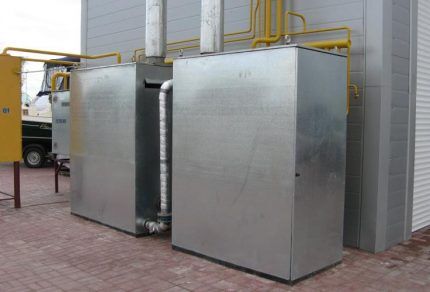
Documentation with gas requirements:
- Biogas – GOST 27577-2000;
- Natural – GOST 5542-2014;
- Liquefied – GOST 20448-90.
Installation, commissioning and maintenance are usually carried out by the manufacturer's employees. The constant presence of maintenance personnel is not necessary.
Purpose and main functions
It is necessary to distinguish the PRC from boiler houses, since according to all documents and legislative acts they represent a separate group of heating equipment. And although they are often called mini-boiler rooms, installation is carried out according to completely different rules.
Outdoor boilers are used to heat both residential and industrial facilities. They are installed to serve kindergartens, schools, hospitals, entertainment, shopping and sports centers. Sometimes they act as a backup source, especially where a continuous supply of heat is required.
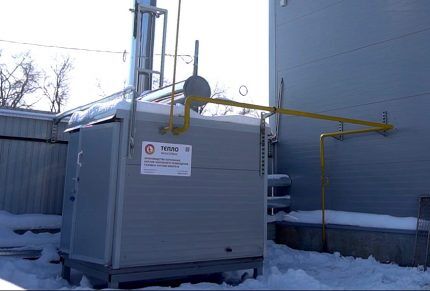
If you need to heat a country house, then low-power equipment is quite suitable for this. Large buildings and industrial enterprises require more powerful equipment; complexes of 2 or more boilers are installed for them.
Outdoor units have become increasingly used due to the following features:
It is also convenient for use that the units are compact in size and yet have great power. They do not require constant attention; for maintenance it is enough to remotely monitor the operation of the boilers in normal mode.
Types and design features
Models of domestic and industrial gas boilers for outdoor installation - prefabricated water-tube structures for heating water. To protect against external aggressive factors, they are enclosed in metal boxes, insulated on all sides with mineral wool or other heat-insulating material.
The models differ in design, but most often the principle of their operation is to use a gas burner. After mixing with air, the fuel is supplied to a multi-flame burner. A gas jet with small holes breaks the fuel stream into parts, resulting in complete combustion. The holes located in the upper part are responsible for draft and air supply.
Pipelines and electrical cables connect the building and the boilers, so they are led inside the facility, where a remote control panel is installed. The boiler can be controlled directly from the service room located inside the building
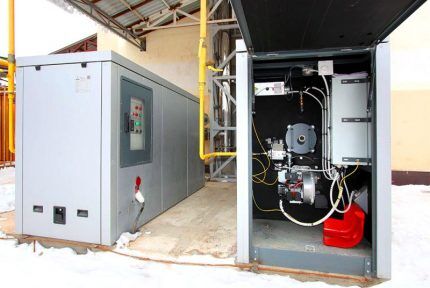
Equipping heating equipment automatic devices able:
- ignite the burner;
- control the operation of light and sound alarms;
- turn off the burner if the fuel indicators deviate from the established ones;
- turn off the system if a leak occurs;
- maintain the volume and temperature of the coolant, etc.
Most of the units, especially low-power representatives, do not require foundation preparation - strengthening the foundation. The finished equipment is simply brought to the chosen location and installed according to the level.
To access the burner and technical components located inside the metal box, one or two walls open.
There are two types of boilers: single and double. Now built-in ones have appeared, but the original models are more popular - if increased power is required, several boilers are simply installed.

The basic model comes with:
- control and measuring instruments;
- mesh filter system;
- pipelines;
- sensors;
- fittings;
- safety valve.
To increase operating efficiency, outdoor boilers are equipped circular pump. For models operating on medium/high pressure gas, installation of gas control units is provided.
Chimneys have different designs, but sandwich chimneys insulated with basalt wool are considered effective. They heat up quickly, which minimizes the formation of condensation and, in the cold season, ice on the walls.
Nuances of installing China
Installation of outdoor gas boilers is carried out in accordance with existing regulatory documentation. But it talks either about boilers for internal use or about boiler rooms located in separate premises, so controversial issues may arise that are resolved by gas services, service companies, and Rostechnadzor.
The main thing is to be able to negotiate with representatives of all authorities and skillfully operate with the provisions of SNiP and GOST.
For those who want to study the regulatory framework, we suggest studying the following documents:
- SP 41-104-2000;
- SNiP 42-01-2002;
- SP 42-101-2003.
But the main document for installing and operating equipment is manufacturer's technical manual.
Conditions for installation of gas structures
PRC are completely ready-to-use structures that require connection and commissioning, so their installation requires only a flat base and permission for installation work.
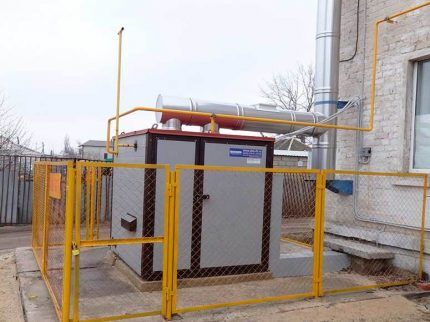
Before installation, it is necessary to obtain specifications from the gas service, which, in turn, is guided by the requirements of the Technical Regulations. The rules for issuing special technical conditions are set out in Decree 1314 (2013), which states that the basis for failure of the installation can only be the lack of technical ability to connect the boiler to the facility.
IN GOST R 54961-2012 it is indicated that the approval of specifications is carried out after checking the compliance of the equipment power, as well as the connection point.
Chimney requirements
Outdoor structures, in the same way as conventional gas boilers, are equipped chimneys, which have the following requirements:
- the diameter of the pipe must be equal to or greater than the boiler pipe;
- the material of manufacture is gas-tight;
- installation of a condensate collector is required;
- the direction of the structure is strictly vertical, in special cases – an inclination angle of up to 30°;
- joints must be sealed;
- The height of the chimney eliminates smoke from the living area and provides good draft - from 5 m or more.
The upper part of the chimney of external gas boilers is closed, just like with conventional ones. deflector — a cap from debris, dirt and street dust.
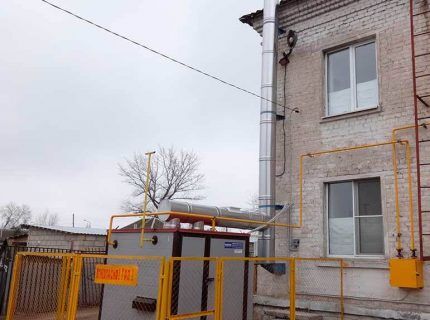
Installation of factory-made pipes proceeds from the bottom up, starting from the boiler. The joints of tees, bends, and corner elements are additionally secured with clamps. If the pipe is attached to the wall, then brackets are installed at intervals of 2 m.
Detailed requirements for the selection and installation of Chinese chimneys are set out in DBN V.2.5-20-2001 And SNiP 2.04.05-91.
Installation and connection rules
The placement and connection of equipment to the central gas supply system is carried out in accordance with the drawn up and agreed upon project. Boilers that are small in weight and volume do not require the construction of a foundation.
They are installed on a flat piece of ground so that the load is distributed evenly over the entire site. For large-scale devices, the foundation construction plan is also included in the overall project.
Depending on the manufacturer’s recommendations, the unit is placed next to the wall of the heated object, at a distance of up to 50 m, or on the roof.
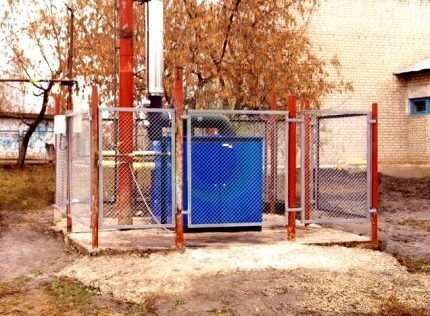
According to the rules, it is necessary to ground the structure, since the boiler is connected to the power supply system. She is responsible for the operation of security alarms, pumps and other automatic equipment.
The unit is connected to the internal heating system by pipes for supplying coolant with a diameter of 50 mm. The pipeline passes through the wall in a sleeve that provides its protection. Entrance structures inside the building are equipped with shut-off valves.
First, the internal system is cleaned and pressurized, and based on the results - if there is no leak, rupture, or pressure drop in the network - a connection is made to the boiler. During the crimping process, the shut-off valves are closed. The heating system must be equipped with air vents at the top points and a drain valve at the bottom.
Installed inside the building expansion tank, selected taking into account the volume and coefficient of expansion of the liquid, pressure and other important parameters.
Start-up and operating requirements
Before putting the boiler into operation, first prepare the heating system: set the recommended pressure, open the shut-off valves on the pipes and in the thermal-mechanical compartment of the unit, fill the heating network with water, eliminate errors, and bleed air.
Then apply voltage to the boiler and check that the phases are connected correctly according to the diagram. At the same stage, the operation of automatic equipment - control and alarm panels - is diagnosed. Lastly, start the pump and check its operation.
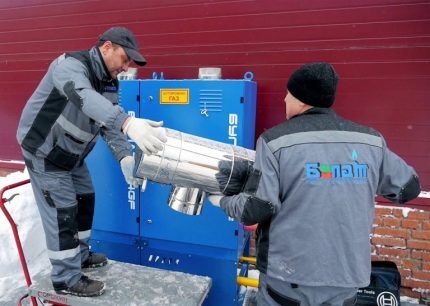
It is necessary to regularly monitor the cleanliness of filters. When dirty, turn off the taps, drain the water, remove the filters and wash the mesh.
If the boiler is turned off for the winter, the heating system and the unit itself are completely freed of water so that the coolant does not freeze in the pipes and rupture them.
Conclusions and useful video on the topic
Maintenance China:
Review of the standard model from the manufacturer:
You won’t be able to purchase a gas outdoor boiler for heating a private home on your own and at random. It must be declared in the house gasification project, and all work must be carried out by specialists or under their supervision.
Unauthorized connection of gas equipment of any type to the house threatens the safety of residents, and is punishable by penalties from regulatory organizations.
Would you like to talk about how you installed a gas boiler during the renovation of your country house? Do you have useful information on the topic of the article that is worth sharing with site visitors? Please write comments in the block form below, ask questions, post photographs.




The best outdoor boiler is RS-H. The rest are just pots...
Good afternoon I don't quite agree with you.According to SP 41-104-2000 - “These rules should be applied when designing newly built and reconstructed autonomous boiler houses intended for heat supply to heating, ventilation, hot water supply and process heat supply systems of industrial and agricultural enterprises, residential and public buildings.”
The boiler is not designed, since it is not an object of capital construction (boiler room).
Hello. Did we miss something or does the boiler house gas supply project not include more boiler installations? 🙂 Boiler installations are always part of the project since they standardize the purpose, type of boiler room building and the safety requirements for it.
Hello! Why does the article not reflect fire safety requirements when placing this equipment? For example, fire safety distances from boilers (which are essentially outdoor installations) must be observed. Also, do not forget that the placement of built-in, attached heat generators (including power up to 360 kW) is prohibited in buildings of certain functional fire hazard classes, for example F1.1 and F1.2 (children's institutions and hotels).